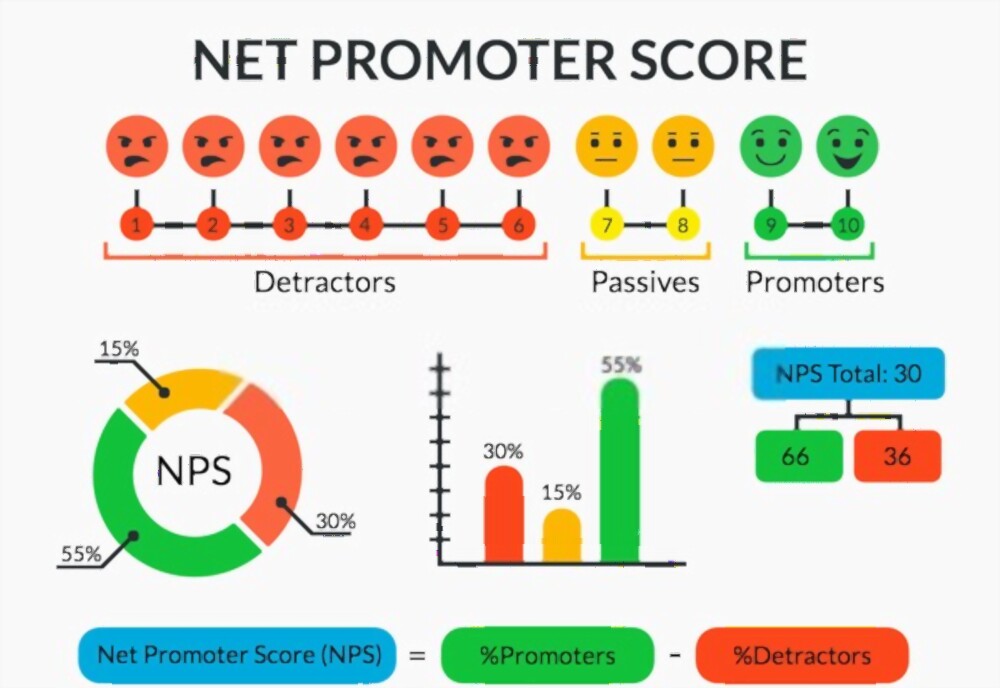Net Promoter Score (NPS) is a tool that gathers and analyzes customer experience with a product, service, or business based on customer satisfaction. It uses a question that assesses consumers’ likelihood to recommend a product, service, or business to a friend or colleague on a scale of 0 to 10.
On the NPS scale, 0 indicates the customer is least likely to recommend the product. On the other hand, a rating of 10 indicates the customers’ extreme likeliness to recommend the product to their friends and colleagues.
This article will discuss how the Net Promoter Score is created, calculated, its benefits, and how you can get good reviews with Greenfinch’s automated NPS tool.

How is the Net Promoter Score calculated?
Net Promoter Score is calculated by subtracting the percentage of detractors from the promoters. For example, if the distractors are 20% and the promotors are 80%, the Net Promoter Score will be 60%, as illustrated below:
80% – 20% = 60%
Consumers rate products or services on a scale of 0 to 10. The NPS analyses the feedback in the following order:
Score 9 – 10
These clients who score a product or service nine or eight are referred to as promoters. They are customers who are extremely satisfied and loyal to the product despite the market competition. They greatly influence the growth of a brand or company.
Score 7 – 8
Customers who give a product or company a score between seven or eight are passive. They are satisfied with the product, but they are prone to competitive options available in the market.
Score 0 – 6
The customers who give this score are referred to as detractors. They are unhappy consumers who are not satisfied with the product and can negatively influence the business through their feedback.

Net Promoter Score Programs
The NPS has two programs;
- Transactional Net Promoter Score
- Relational Net Promoter Score.
Transactional NPS, as the name suggests, is a survey sent to a customer after they purchase or interact with a product or business. Relational NPS is a survey that is done on specific occasions.
Using both the transactional and relational score provides an in-depth analysis of customer experience.
Follow up questions for NPS
Follow-up questions can be used with the main rating question on NPS. They provide a more detailed understanding of customer needs and experience with a brand or company.
The question can ask the consumer to explain why they scored a product or service a specific score. The response provided by the consumer can help you realize what the business promoters love about a product or what the distractors dislike. The information can enable you to make the necessary adjustments to convert distractors to promoters.
Another follow-up question can be explicitly designed for distractors. The question can ask what changes would enable the customers to have a better customer experience. The response can be considered when business decisions are reviewed.
How do you create an NPS survey?
- The first step is giving the survey a customized title or name.
- Add a short description of what the survey is for and the time it will take to complete.
- Add the mandatory NPS question that the customer has to answer.
- Add follow-up questions and activate the survey to start receiving responses from customers.
- Remember to create a thank you note to appreciate your customers for filling the survey.
You can use various NPS software to create a survey. This software includes Trust Mary, Hotjar, Promote.io, Delighted, and Survicate, among others. A customer experience management platform is another way of creating the survey.
When creating an NPS survey, it is essential to note that the shorter the survey is, the better.
Five benefits of NPS to a business?
The benefits of using the NPS tool in your business include;
- It is a tool that you can use for an extended period because it has transactional and relational assessment options. It provides you with information on how seasonal occurrences affect customer experience.
- You can generate changes driven by customer recommendations obtained from follow-up questions. Addressing the customer needs gives them a sense of ownership which leads to loyalty.
- NPS enables you to gauge your customers’ satisfaction and loyalty. It helps you to assess the possibility of a customer making a repeat purchase.
- It is a simple, effective, and easy-to-use tool to use to measure customer satisfaction. Its formula involves subtracting the percentage of distractors from the promoters.
- The ratings prove the credibility of a company or product and help convert potential to actual clients. It leads to more sales generation and an increase in the customer base.
How can you get good reviews with Greyfinch’s Automated NPS Tool?
Greyfinch’s Automated NPS tool helps you receive customer feedback on Facebook, Google, or Yelp by sending automatic SMS to patients who complete specific appointments that you set.
This tool will only ask patients who give a high NPS score that you set to review you. Those who give a low rating will be asked for feedback so you can address with that patient.
The automated service improves efficiency and provides the best avenue to collect customer reviews and feedback.
The instant review using Greyfinch’s automated NPS tool can convert prospective clients to actual customers.
To get good reviews on this tool:
- Ensure you fulfill your patients’ expectations. You can do this by providing excellent services to get you good reviews to improve your ranking against competitors.
- Share previous positive reviews on your website will inspire other consumers to follow suit and give a good review.
- Create incentives to encourage your customers to give a good review.
- Having different options of giving reviews will also prompt the customer to give a good review. Options include Yelp, Facebook, and Google as used in Greenfinch’s NPS tool.
Parting Shot
The Net Promoter Score will help you assess the satisfaction of your customers and help you make the necessary changes that will maintain the promoters and convert the passive and distractor customers to promoters. It will assist you in developing strategies for growth.









